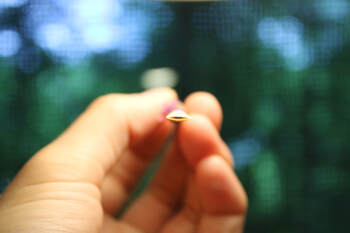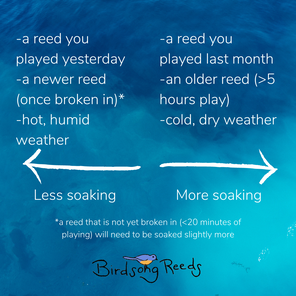 Preparing your reed to play, A reed must always be properly soaked prior to playing. Preparing your reed before putting your oboe together will ensure that the first sounds you make feel comfortable and are made with a beautiful, responsive, resonant sound. If a reed is under-soaked it will likely be closed and not vibrate, if a reed is over-soaked it will likely be too open and require too much effort to vibrate. How much soaking your reed needs will depend primarily on three factors. First, let’s look at what a properly soaked reed looks like. When a reed is properly soaked, it will be able to peep from a breath attack with minimal delay, and will crow octave Cs. It should be able to sustain a peep for as long as you can blow. The opening should be symmetrical opening wider at the center, meeting closed at both sides (see above picture for reference). When pressed closed, the center closes last and evenly. A reed in this state is ready to be played. How do we get there from a dry reed directly out of your case? The reed must be soaked in warm water in a small cup (like an old film canister, shot glass, or medicine bottle). Reeds should never be played without soaking or by soaking in saliva. How long to soak a reed is dependent on:
Depending on these three aspects, a reed will need to be soaked more/less,
With this information, you will be able to judge for yourself how long your reed should optimally be soaked for before playing. Always remember to be gentle with the tip of the reed when placing it in your soaking container. With a shorter soaking time, a short dip in the water with another 30 seconds for the reed to absorb the water may be enough. For a longer soaking time, up to one minute in the water is recommended, any longer and the reed will risk becoming water-logged. Happy oboe-ing! 🕊️
0 Comments
Leave a Reply. |
AuthorI am an oboist and reed maker. Archives
April 2023
Categories
|


 RSS Feed
RSS Feed